The trinket box market is estimated to be valued at USD 576.3 million in 2025 and is projected to reach USD 965.9 million by 2035, registering a compound annual growth rate (CAGR) of 5.3% over the forecast period.
The year-on-year (YoY) growth analysis of the trinket box market shows consistent expansion from USD 576.3 million in 2025 to USD 965.9 million by 2035, reflecting a compound annual growth rate (CAGR) of 5.3%. The market is expected to experience steady growth throughout the decade, with values increasing from USD 576.3 million in 2025 to USD 606.9 million in 2026, continuing its upward trajectory to USD 639 million by 2027. This growth is likely to be driven by a combination of factors such as the increasing demand for home decor items and personalized gift solutions, with trinket boxes being seen as both functional and decorative.
Looking ahead, the market is projected to see steady YoY increases in demand, as consumers continue to seek stylish and compact storage solutions. The growing popularity of artisanal and handmade products is likely to contribute to this trend, as well as the expansion of online retail platforms. By 2035, the trinket box market is expected to have matured, reaching USD 965.9 million. This consistent growth indicates that trinket boxes will continue to find relevance in both the home decor and gifting sectors, suggesting that companies may benefit by focusing on unique designs and personalized offerings to capture a broader customer base.
Retail operations encounter merchandising challenges as trinket box displays require coordination between seasonal product rotation, gift packaging services, and customer consultation about personalization options while managing inventory levels across different materials, sizes, and decorative themes. Store managers work with visual merchandising teams to establish display strategies that showcase product variety while coordinating with suppliers about custom engraving services and special occasion inventory planning that addresses both gift-giving seasons and everyday purchase patterns.
Cross-functional coordination between product design teams and manufacturing operations creates ongoing dialogue about aesthetic appeal versus production feasibility and cost considerations. Designers work with production managers to evaluate new material options and decorative techniques while managing lead times for specialized components including hinges, lining materials, and surface treatments that may affect both product quality and manufacturing consistency across different production volumes.
E-commerce operations experience fulfillment complexity as online trinket box sales require coordination between product photography, customization processing, and protective packaging procedures while managing customer expectation communication about personalization timelines and shipping protection for delicate decorative items. Customer service teams coordinate with production facilities to establish customization workflows while working with shipping departments about packaging specifications that prevent damage during transit.
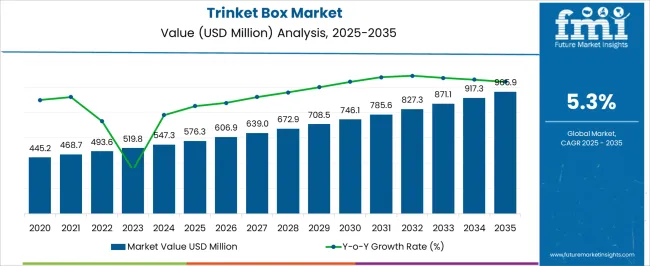
| Metric | Value |
|---|---|
| Trinket Box Market Estimated Value in (2025 E) | USD 576.3 million |
| Trinket Box Market Forecast Value in (2035 F) | USD 965.9 million |
| Forecast CAGR (2025 to 2035) | 5.3% |
The trinket box market is experiencing consistent growth, supported by increasing consumer interest in personalized and decorative storage solutions that combine functionality with aesthetic appeal. Demand is being driven by the rising popularity of handcrafted and designer accessories, coupled with the growing gifting culture in both personal and corporate settings. Expanding e-commerce platforms and global artisanal trade networks are enabling wider market access, allowing buyers to choose from a variety of styles, materials, and sizes.
Manufacturers are focusing on sustainable production, using eco-friendly materials and ethical sourcing to align with evolving consumer preferences. Innovations in design, including intricate detailing and customization options, are further enhancing the appeal of trinket boxes across diverse customer segments.
Growing tourism and souvenir markets are contributing to sales, as trinket boxes are often purchased as collectible items With increasing demand for both premium and budget-friendly products, the market is expected to witness steady expansion, driven by design innovation, material diversity, and global retail accessibility.
The trinket box market is segmented by material, style, size, price range, end use, and geographic regions. By material, trinket box market is divided into Wood, Metal, Glass, Plastic, Ceramic, and Others (marble, jade, etc.). In terms of style, trinket box market is classified into Modern/contemporary, Traditional, and Customized. Based on size, trinket box market is segmented into Small, Medium, and Large. By price range, trinket box market is segmented into Mid, Low, and High. By end use, trinket box market is segmented into Gift purposes and Personal usage. Regionally, the trinket box industry is classified into North America, Latin America, Western Europe, Eastern Europe, Balkan & Baltic Countries, Russia & Belarus, Central Asia, East Asia, South Asia & Pacific, and the Middle East & Africa.
The wood segment is projected to account for 36.2% of the trinket box market revenue share in 2025, making it the leading material type. This dominance is being driven by the enduring appeal of wood as a durable, versatile, and aesthetically pleasing material that aligns with both traditional and modern design sensibilities. Wooden trinket boxes are valued for their ability to be intricately carved, hand-painted, or polished to achieve unique finishes, enhancing their decorative and collectible value.
The segment is benefiting from growing consumer preference for sustainable and eco-friendly products, as wood is often sourced from renewable resources. Additionally, the strength and longevity of wooden boxes make them a preferred choice for storing valuable keepsakes and jewelry.
Advances in woodworking techniques and finishing processes are enabling manufacturers to offer a wide range of designs at different price points, catering to both premium and mass-market buyers The combination of durability, natural beauty, and customization potential is reinforcing the segment’s leadership in the market.
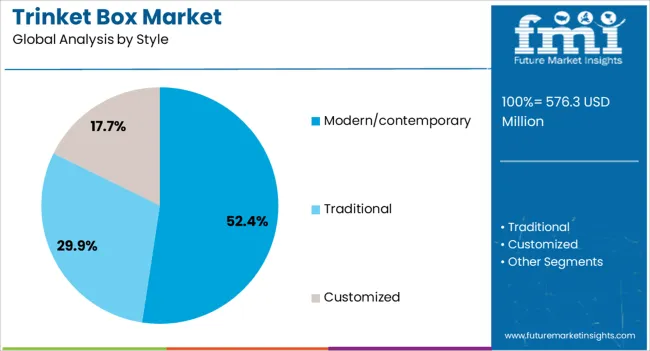
The modern or contemporary style segment is anticipated to hold 52.4% of the trinket box market revenue share in 2025, establishing itself as the dominant style category. This leadership is being supported by the growing preference for minimalist, sleek, and versatile designs that complement modern home décor trends. Contemporary trinket boxes often feature clean lines, innovative materials, and functional enhancements, appealing to a broad consumer base seeking both style and practicality.
The segment is benefiting from the influence of interior design trends that prioritize clutter-free organization while maintaining aesthetic appeal. Increased consumer exposure to global design influences through online retail and social media is driving demand for contemporary styles.
Manufacturers are responding by introducing designs that blend modern aesthetics with cultural elements, creating products that resonate with diverse markets The adaptability of contemporary designs to various living spaces, from urban apartments to luxury homes, is further strengthening their position as the preferred choice among style-conscious buyers.
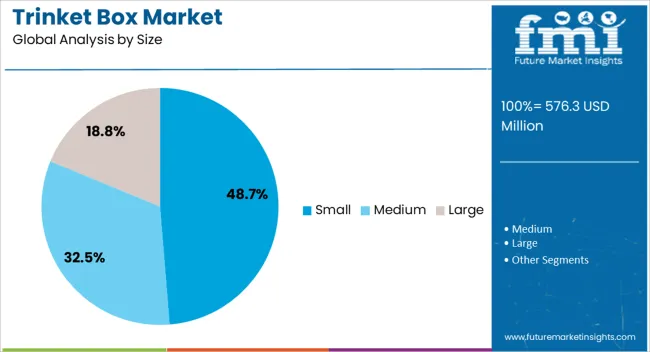
The small size segment is expected to capture 48.7% of the trinket box market revenue share in 2025, securing its position as the leading size category. This dominance is being fueled by the practicality and portability of smaller boxes, which make them ideal for storing jewelry, keepsakes, and other personal items while occupying minimal space. Small trinket boxes are highly popular as affordable gifting options, appealing to a wide consumer demographic.
Their versatility allows them to serve both decorative and functional purposes, making them suitable for bedrooms, living spaces, and travel. Manufacturers are offering a wide range of designs in small formats, incorporating premium materials and intricate detailing to enhance their perceived value.
The segment is also benefiting from strong sales through online platforms, where compact sizes reduce shipping costs and broaden accessibility As consumer demand grows for multifunctional, stylish, and space-saving storage solutions, the small size category is expected to maintain its leadership in the global market.
The trinket box market is experiencing growth, driven by rising demand for personalized, eco-friendly, and luxury products. Opportunities in sustainable materials and premium offerings are expanding, while trends show a shift toward custom and artisanal designs. However, the market faces challenges due to intense competition and pricing pressure. As consumers seek unique, high-quality, and environmentally responsible options, the market outlook remains positive, with potential for innovation and differentiation continuing to shape the industry.
The trinket box market is witnessing growing demand, particularly driven by consumers' interest in personalized and aesthetically pleasing storage solutions. As gifting culture thrives globally, custom-designed trinket boxes are becoming popular for special occasions like birthdays, weddings, and holidays. The desire for unique, personalized items has led to a rise in handcrafted, artisanal products. As a result, manufacturers are expanding their offerings to include various materials, designs, and customization options, further fueling demand across both online and offline retail platforms.
There is a significant opportunity in the market for eco-friendly and sustainably sourced trinket boxes. As consumers become more environmentally conscious, there is an increasing demand for products made from recycled or renewable materials. Manufacturers are incorporating eco-friendly materials such as bamboo, recycled wood, and biodegradable plastics to appeal to this growing segment. This shift is not only responding to consumer preferences but also tapping into the broader trend of sustainability, offering brands the chance to stand out with environmentally responsible offerings.
The luxury segment of the trinket box market is expanding as affluent consumers seek premium, high-quality products. Fine materials such as velvet, leather, and precious metals are being used to create trinket boxes that serve as both functional and decorative pieces. The growing interest in high-end, bespoke home décor is driving the trend of exclusive trinket boxes that reflect a sense of sophistication and elegance. As disposable incomes rise, particularly in emerging markets, the demand for luxury trinket boxes is expected to grow.
One of the key challenges in the trinket box market is intense competition, especially with the proliferation of low-cost, mass-produced items from emerging markets. Pricing pressure from these products, coupled with consumers’ increasing preference for affordability, is making it difficult for higher-end brands to maintain profit margins. Additionally, counterfeiting and imitation products are common, which further complicates the competitive landscape. Manufacturers must focus on offering differentiated products through unique designs and quality materials to remain competitive in this crowded market.
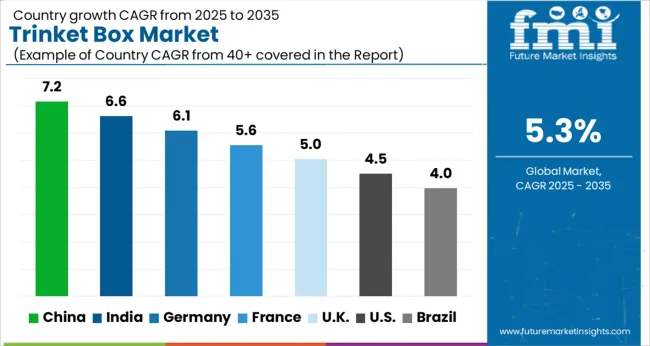
| Country | CAGR |
|---|---|
| China | 7.2% |
| India | 6.6% |
| Germany | 6.1% |
| France | 5.6% |
| UK | 5.0% |
| USA | 4.5% |
| Brazil | 4.0% |
The global trinket box market is projected to grow at a 5.3% CAGR from 2025 to 2035. China leads with a growth rate of 7.2%, followed by India at 6.6%, and Germany at 6.1%. The United Kingdom records a growth rate of 5%, while the United States shows the slowest growth at 4.5%. The varying growth rates are driven by factors such as rising disposable incomes, gifting culture, and increasing demand for decorative home accessories. Emerging markets like China and India are experiencing higher growth due to rapid urbanization, rising middle-class populations, and the expansion of online shopping. In more mature markets like the USA and the UK,steady growth is supported by demand for sustainable, personalized, and high-quality trinket boxes. This report includes insights on 40+ countries; the top markets are shown here for reference.
The trinket box market in China is projected to grow at a robust CAGR of 7.2%. As the largest consumer market globally, China has seen a significant rise in consumer spending, particularly in the personal goods and accessories segments. The growing middle class, along with an increasing appetite for luxury and decorative items, is fueling demand for trinket boxes in both urban and rural regions. Additionally, China’s expanding e-commerce sector is further driving market growth, as online platforms make trinket boxes more accessible to a wider consumer base. With China’s focus on aesthetics and home decor, trinket boxes are becoming a popular choice for decorative and functional use in homes and gift-giving. The market is expected to continue growing due to these factors, along with a shift toward more personalized and unique designs.
The trinket box market in India is projected to grow at a CAGR of 6.6%. India’s rapidly expanding middle class and increasing disposable income are major factors driving demand for decorative and functional home accessories. As gifting culture continues to thrive, trinket boxes are gaining popularity as a stylish and functional choice for both personal and gift purposes. Furthermore, India’s rich tradition of arts and crafts is contributing to the growing demand for intricately designed trinket boxes, especially in regional markets. The rise of e-commerce and online shopping is also expanding the reach of these products, making them more accessible to urban and rural consumers alike. With the growing demand for affordable luxury items, India’s trinket box market is expected to continue growing at a steady pace.

The trinket box market in Germany is projected to grow at a CAGR of 6.1%. Germany’s strong tradition of craftsmanship and luxury home decor is contributing to the growing demand for trinket boxes, especially in urban areas. As consumers seek personalized, high-quality decorative items, trinket boxes are becoming an essential part of home decor. Germany’s emphasis on sustainable and eco-friendly products is also influencing the market, with consumers opting for trinket boxes made from environmentally friendly materials. The rise of gifting culture in Germany, particularly during special occasions and holidays, is further driving the demand for unique and intricately designed trinket boxes. As more consumers focus on quality and design, the trinket box market is expected to grow at a steady pace in Germany.
The trinket box market in the United Kingdom is projected to grow at a CAGR of 5%. The UK has seen a steady demand for decorative home accessories, including trinket boxes, driven by consumer interest in unique and personalized items. The gifting culture, particularly during holidays, is also driving demand for trinket boxes, as they are seen as both functional and aesthetically pleasing gifts. Additionally, with increasing awareness of sustainability, consumers in the UK are opting for eco-friendly and ethically produced trinket boxes. The trend for artisanal and handcrafted products is also contributing to the market’s growth, as more consumers seek unique, high-quality items for their homes.
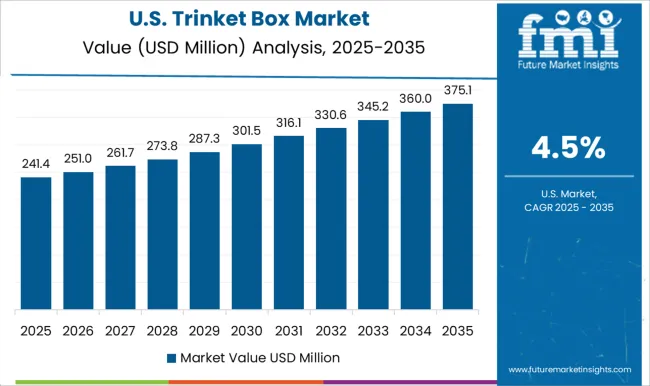
The trinket box market in the United States is projected to grow at a CAGR of 4.5%. The USA market is driven by an increasing interest in decorative and personalized home accessories, with trinket boxes gaining popularity as both functional and ornamental items. The gifting culture in the USA is robust, with trinket boxes often chosen as thoughtful and meaningful gifts for holidays, birthdays, and special occasions. E-commerce platforms are playing a significant role in driving the growth of the market by providing easier access to a wide range of trinket boxes. As consumers seek more unique and high-quality decorative items, the USA market is expected to see steady growth in the demand for trinket boxes.
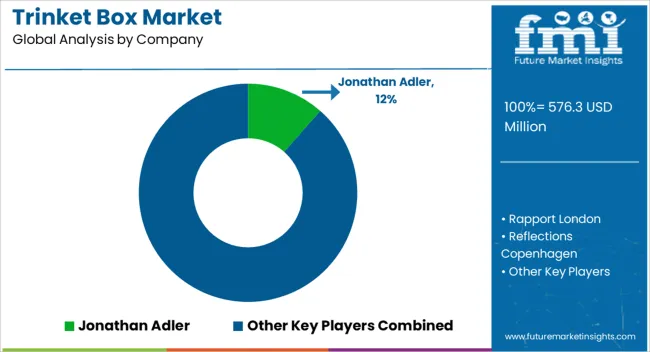
The trinket box market is defined by a blend of luxury craftsmanship, artistic innovation, and cultural heritage, appealing to high-end consumers seeking collectible and decorative statement pieces. Leading brands such as Jonathan Adler, Rapport London, and Reflections Copenhagen have established strong market positions by merging modern design aesthetics with artisanal craftsmanship, producing pieces that emphasize sophistication, individuality, and interior décor value. Their focus on limited editions, exclusive materials, and designer collaborations enables them to target affluent buyers across major luxury markets in Europe, North America, and Asia.
L’Objet and Bordallo Pinheiro specialize in artistically inspired trinket boxes, using porcelain, glass, and precious metals to create visually striking, handcrafted collections that blur the line between fine art and functional design. Christofle (Orfèvrerie Christofle), Ginori 1735 S.p.A., and Fornasetti distinguish themselves in the bespoke and heritage luxury segment, offering personalized and collectible creations that serve as heirloom-quality décor pieces.
Wedgwood brings a heritage-driven approach, preserving classical motifs and craftsmanship traditions that attract collectors and gift buyers. Meanwhile, Shanghai Tang adds a modern Asian luxury identity, blending Eastern design elements with Western craftsmanship. In this niche but competitive market, long-term success is anchored in brand legacy, exclusivity, premium retail partnerships, and the ability to fuse artistry with timeless functionality.
| Item | Value |
|---|---|
| Quantitative Units | USD 576.3 Million |
| Material | Wood, Metal, Glass, Plastic, Ceramic, and Others (marble, jade, etc.) |
| Style | Modern/contemporary, Traditional, and Customized |
| Size | Small, Medium, and Large |
| Price Range | Mid, Low, and High |
| End Use | Gift purposes and Personal usage |
| Regions Covered | North America, Europe, Asia-Pacific, Latin America, Middle East & Africa |
| Country Covered | United States, Canada, Germany, France, United Kingdom, China, Japan, India, Brazil, South Africa |
| Key Companies Profiled | Jonathan Adler, Rapport London, Reflections Copenhagen, L’Objet, Bordallo Pinheiro, Christofle (Orfèvrerie Christofle), Ginori 1735 S.p.A., Fornasetti, Wedgwood, Shanghai Tang. |
| Additional Attributes | Dollar sales by material type (wood, metal, plastic, fabric) and design (vintage, modern, handcrafted) are key metrics. Trends include rising demand for personalized and decorative boxes, especially in gift and home décor markets. Regional preferences, customization options, and evolving fashion trends are influencing market growth. |
The global trinket box market is estimated to be valued at USD 576.3 million in 2025.
The market size for the trinket box market is projected to reach USD 965.9 million by 2035.
The trinket box market is expected to grow at a 5.3% CAGR between 2025 and 2035.
The key product types in trinket box market are wood, metal, glass, plastic, ceramic and others (marble, jade, etc.).
In terms of style, modern/contemporary segment to command 52.4% share in the trinket box market in 2025.






Our Research Products

The "Full Research Suite" delivers actionable market intel, deep dives on markets or technologies, so clients act faster, cut risk, and unlock growth.

The Leaderboard benchmarks and ranks top vendors, classifying them as Established Leaders, Leading Challengers, or Disruptors & Challengers.

Locates where complements amplify value and substitutes erode it, forecasting net impact by horizon

We deliver granular, decision-grade intel: market sizing, 5-year forecasts, pricing, adoption, usage, revenue, and operational KPIs—plus competitor tracking, regulation, and value chains—across 60 countries broadly.

Spot the shifts before they hit your P&L. We track inflection points, adoption curves, pricing moves, and ecosystem plays to show where demand is heading, why it is changing, and what to do next across high-growth markets and disruptive tech

Real-time reads of user behavior. We track shifting priorities, perceptions of today’s and next-gen services, and provider experience, then pace how fast tech moves from trial to adoption, blending buyer, consumer, and channel inputs with social signals (#WhySwitch, #UX).

Partner with our analyst team to build a custom report designed around your business priorities. From analysing market trends to assessing competitors or crafting bespoke datasets, we tailor insights to your needs.
Supplier Intelligence
Discovery & Profiling
Capacity & Footprint
Performance & Risk
Compliance & Governance
Commercial Readiness
Who Supplies Whom
Scorecards & Shortlists
Playbooks & Docs
Category Intelligence
Definition & Scope
Demand & Use Cases
Cost Drivers
Market Structure
Supply Chain Map
Trade & Policy
Operating Norms
Deliverables
Buyer Intelligence
Account Basics
Spend & Scope
Procurement Model
Vendor Requirements
Terms & Policies
Entry Strategy
Pain Points & Triggers
Outputs
Pricing Analysis
Benchmarks
Trends
Should-Cost
Indexation
Landed Cost
Commercial Terms
Deliverables
Brand Analysis
Positioning & Value Prop
Share & Presence
Customer Evidence
Go-to-Market
Digital & Reputation
Compliance & Trust
KPIs & Gaps
Outputs
Full Research Suite comprises of:
Market outlook & trends analysis
Interviews & case studies
Strategic recommendations
Vendor profiles & capabilities analysis
5-year forecasts
8 regions and 60+ country-level data splits
Market segment data splits
12 months of continuous data updates
DELIVERED AS:
PDF EXCEL ONLINE
Box Liners Market Size and Share Forecast Outlook 2025 to 2035
Boxboard Packaging Market Analysis - Size, Share, and Forecast Outlook 2025 to 2035
Box Compression Tester Market Size and Share Forecast Outlook 2025 to 2035
Box Latch Market Size and Share Forecast Outlook 2025 to 2035
Box Pouch Market by Pouch Type from 2025 to 2035
Box Filling Machine Market from 2025 to 2035
Box and Carton Overwrap Films Market Demand and Growth
Box and Carton Overwrapping Machines Market Insights and Growth 2025 to 2035
Boxcar Scars Market – Demand, Growth & Forecast 2025 to 2035
Box Sealing Machines Market Trends – Growth & Forecast 2025 to 2035
Competitive Breakdown of Box Pouch Providers
Market Share Insights of Boxboard Packaging Providers
Box Latch Market Positioning & Competitive Analysis
Industry Share Analysis for Box Liners Companies
Carboxylate-Modified Magnetic Beads Market Analysis - Size, Share, and Forecast Outlook 2025 to 2035
Carboxymethyl Tamarind Kernel Powder Market Size and Share Forecast Outlook 2025 to 2035
Carboxymethyl Tamarind Gum (CMT) Market Size and Share Forecast Outlook 2025 to 2035
Carboxylic Acid Market Size and Share Forecast Outlook 2025 to 2035
Carboxylated Nitrile Rubber Market Size and Share Forecast Outlook 2025 to 2035
Carboxy Therapy Market Size and Share Forecast Outlook 2025 to 2035

Thank you!
You will receive an email from our Business Development Manager. Please be sure to check your SPAM/JUNK folder too.
Chat With
MaRIA